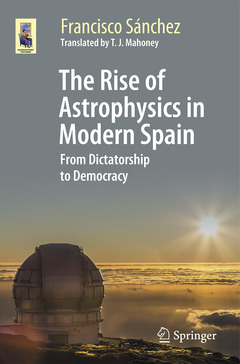Description
The Rise of Astrophysics in Modern Spain, 1st ed. 2021
From Dictatorship to Democracy
Astronomers' Universe Series
Author: Sánchez Francisco
Language: English
Subjects for The Rise of Astrophysics in Modern Spain:
296 p. · 15.5x23.5 cm · Paperback
Description
/li>Contents
/li>Biography
/li>Comment
/li>
With foreword by astrophysicist and Queen guitarist Brian May
This book describes the unlikely development of astrophysics in Spain, set against the final decade of Franco?s rule and the country?s transition to democracy.
The author, Founding Director of Spain?s Instituto de Astrofísica de Canarias, gives a firsthand account of his own and others? odyssey in establishing the field in Franco?s Spain, showing how in a mere half-century, Spain was able to transform from a scientific backwater to a world player in astronomy and astrophysics. The book is a behind-the-scenes, warts-and-all depiction of how Big Science gets done, showing the motivations?sometimes as entertaining as they are infuriating?that drive scientific institutions and the scientists who work for them.
Many astronomers, both professional and amateur, and historians know of the great scientific work being done in Spain, but there is very little published information available about the complex story underlying it. This English edition now makes that story accessible for the lay reader. With its casual, yet captivating narrative, the book is a rare and inspiring contribution to the history of astrophysics, science policy, education and outreach.
Chapter 1. Perhaps it all began with an eclipse (1959–1961).- Chapter 2. Izaña (1961–1963).- Chapter 3. Tenerife and Mount Teide on the Moon (1724–1914).- Chapter 4. We are stardust (1962–1968).- Chapter 5. The zodiacal light (1962–1982).- Chapter 6. Astronomical site testing (1961–1974).- Chapter 7. Astrophysics versus astronomy (1961–1972).- Chapter 8. Astrophysics enters the Spanish university curriculum (1970–1985).- Chapter 9. The reluctant chancellor (1976–1980).- Chapter 10. A multinational astrophysics treaty (1960–2014).- Chapter 11. Telescopes versus military radars (1977–1978).- Chapter 12. Science meets politics: the Law of Astrophysics and its avatars (1975–2011).- Chapter 13. Royalty and heads of state above the clouds (1985).- Chapter 14. The Sky Law (1978–2017).- Chapter 15. The IAC: a dream come true (1971–present).- Chapter 16. Towards excellence in research (1971–present).- Chapter 17. Astronomical instrumentation, technology transfer, and its impact on industry (1974–present).- Chapter 18. The rise of space astrophysics in Spain (1942–present).- Chapter 19. Training future generations: the Canary Islands Winter School of Astrophysics (1989–present).- Chapter 20. Bringing Astronomy to the public (1986–present).- Chapter 21. The biggest, most advanced telescope in the world (1989–present).- Chapter 22. The European Extremely Large Telescope: dealings with ESO (1961–present).- Chapter 23. The Starlight Foundation: a step beyond astrotourism (2008–present).- Chapter 24. Astrophysics in Spain: the wider picture (1974–present).
Professor Francisco Sánchez played a leading role in the introduction of astrophysics to Spain. During the sixties he carried out site testing at Izaña (Tenerife) to confirm the suitability of the site for the establishment of an astronomical observatory. Since then, his goal has always been to promote the Canarian summits as ideal locations for advanced telescopes and to promote the skies above the Canarian observatories as a natural resource to be exploited for scientific research. He founded the Instituto de Astrofísica de Canarias (IAC), which came into existence in 1982 and is now a leading astrophysical research centre. Under Sánchez’s direction, a key activity of the IAC was, and still is, technology transfer, its efforts in this direction coming to full fruition with the building of the 10.4 metre Gran Telescopio Canarias and the IAC’s participation in major space astrophysical missions. Professor Sánchez retired in 2013 and holdsthe official title of Founding Director of the IAC.
Terry Mahoney is a scientific editor and translator at the Research Department of the Instituto de Astrofísica de Canarias. He joined the IAC in 1989. From 1993 to 1995 he was an astronomer at GRANTECAN, S.A. on a campaign to choose between two candidate sites for the emplacement of the 10.4 metre GTC at Roque de los Muchachos Observatory. His research interests include the structure of the Galaxy, astronomical terminology and nomenclature, and the life and work of Johannes Kepler. He has been an astronomy adviser to the Oxford English dictionary since 1993 and is Editor-in-Chief of Springer's Compendium of the Astronomical Lexicon, the first instalment of which was published in 2014. He is a member of the IAU, the Spanish Astronomical Society, and the European Astronomical Society.
These books may interest you

Highlights of Spanish Astrophysics V 210.99 €



